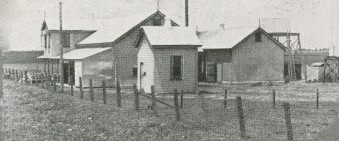Clifton, a rural town, is 40 km south of Toowoomba. It was named after the Clifton pastoral property (1843) and was the administrative centre of the Clifton Shire.
The township came about from the opening of the railway line from Toowoomba to Hendon (1869), but was limited to the station, a hotel and a few buildings for several years. Spring Creek predated Clifton, and retarded its growth until the late 1880s.
Homestead selections were taken up in the 1870s-80s, and the Clifton township was surveyed and lots sold in 1875. A school was opened in 1876. The Clifton local government division was formed in 1879, meeting at Allora until 1891, when the venue was changed to the Clifton railway station. By then, the town was on the move: Catholic and Church of England churches were opened in 1888-89, a school of arts and the Presbyterian church were opened in 1891, and a shire office was built. The black alluvial soil grew good wheat and supported a growing dairy industry. Farms were closely-settled and the last of the large pastoral estates was subdivided in 1911. In 1903 Clifton was described in the Australian handbook:

The Clifton dairy factory was opened in 1908 and enlarged with a new building in 1933. By 1940 it had 522 suppliers. In the 1920s the town gained new and better facilities: the Tivoli picture theatre (1921) and a new memorial hall with a school of arts (1926). Misfortune came with the destruction of the hall in 1940, the fires consuming library contents and historic materials. Reticulated electricity was switched on in 1934.
The intervention of the Depression and the war suspended most projects except for new shire offices (1941) and an early postwar co-operative hospital (1949). Reticulated town water (1964) and sewering (1972) completed the range of town utilities, and the modern essentials, a high school and a swimming pool, were opened in 1966 and 1967. While those facilities were being built dairying was in decline. The dairy factory was closed in 1966 – later becoming home to the historical society – and wheat growing was reduced in favour of barley and other cereals. The silos at the railway station were kept working at capacity.
Clifton's population has grown since the 1980s as it is within commuting distance of Toowoomba and Warwick.
Clifton has local shops, a town newspaper, four churches, a memorial hall (1919), a swimming pool, a showground, Catholic and State primary schools, a high school (1966), bowls, golf, an annual race meeting, and a hospital. Some local shops in Fisher Street were destroyed by fire in 2008.
Its census populations have been:
| Census Date | Population |
|---|---|
| 1891 | 278 |
| 1901 | 453 |
| 1921 | 992 |
| 1954 | 945 |
| 1971 | 756 |
| 1981 | 659 |
| 1986 | 765 |
| 1991 | 805 |
| 1996 | 833 |
| 2001 | 878 |
| 2006 | 1067 |
| 2011 | 1375 |
Beverley J. Irwin, ed, A million bushels of wheat, Clifton, Clifton Shire Council, 1989

